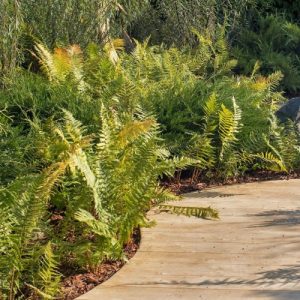Autumn Fern

- Botanical Name: Dryopteris erythrosora
- Family Name: Aspleniaceae
- Stems: 18-24 inches
- Temperature: 15°C - 24°C
- Others: Moist, shady spots and cool weather
Overview
Product Description
Emperors of the Forest Floor: The Reign of Autumn Ferns
Origins and Seasonal Splendor
The Autumn Fern, known botanically as Dryopteris erythrosora, hails from the lush landscapes of East Asia, with its natural habitat spanning across China, Japan, Korea, and the Philippines. This hardy fern is celebrated for its foliage that dresses in a spectrum of colors throughout the seasons. In spring, it dons coppery-red attire, which gradually transitions to a vibrant green as the season progresses. This metamorphosis of color makes the Autumn Fern a dynamic addition to any garden, reflecting the changing palette of nature.

Autumn Fern
Versatility in Habitat
Autumn Ferns showcase an impressive adaptability, thriving in environments ranging from full shade to full sun, though they favor the cool comfort of partial to full shade. They find their niche in soil that is both moist and well-draining, with a talent for flourishing in a variety of soil types from clay to limestone to sandy loam. These ferns are also forgiving when it comes to soil pH, comfortably residing in conditions between acidic and neutral, with an optimal range of 5.0 to 7.0. This flexibility makes the Autumn Fern a resilient choice for gardens with varying soil conditions.
The Elegant Fronds
The vegetative fronds of the Autumn Fern are a sight to behold, with their delicate, pale green hue and an elegant form that draws inspiration from the ostrich feather, thus earning the fern its whimsical name. The stipe, or leaf stem, is a rich brown, measuring 6-10 centimeters in length, featuring distinct grooves and a triangular base that sports a keel-like protrusion covered in protective scales. The lamina, or leaf blade, is lanceolate or oblanceolate, stretching 0.5 to 1 meter in length with a center width of 17-25 centimeters, narrowing gracefully towards the base. The fronds are twice deeply divided, presenting 40-60 pairs of pinnae. The middle pinnae, shaped like lances or linear-lances, span 10-15 centimeters in length and 1-1.5 centimeters in width, pinnately incised into 20-25 pairs of segments arranged in a comb-like pattern. This intricate leaf structure not only lends visual appeal but also facilitates efficient photosynthesis and moisture retention, allowing the Autumn Fern to thrive in its chosen environment.
Autumn Fern’s Hardy Nature
Autumn Fern (Dryopteris erythrosora) is a resilient species that can thrive across a spectrum of climates, from frosty regions to warmer zones. It flourishes in USDA hardiness zones 5-9, showcasing its adaptability to various temperature conditions. This fern is capable of withstanding cold temperatures down to -10°F (-20°C), making it a hearty choice for cooler climates. However, it’s important to note that in more northerly states, it might struggle due to its semi-evergreen nature in colder climates. Autumn Ferns are typically evergreen but can lose their fronds in harsh winters, yet they maintain a bushy and impressive presence throughout the year in milder zones like USDA zone 8.
Autumn Fern’s Versatile Landscape Roles
Autumn Fern is a versatile species suitable for a variety of garden settings. It can be used as a ground cover, an understory plant, or in containers, making it an excellent choice for adding texture and color to shaded areas of the garden. Its ability to tolerate both full sun and partial shade, along with its preference for moist but well-drained soil, makes it a low-maintenance addition to landscapes. Indoors, Autumn Fern can be a beautiful houseplant, bringing a touch of the outdoors in with its lush, arching fronds. It’s also known for its air-purifying qualities, enhancing the vitality of indoor environments by improving air quality.










